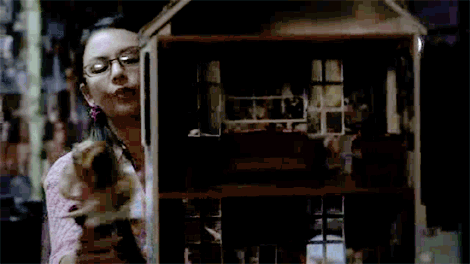Sharp Object, by Gillian Flynn, is the mystery of the Wind Gap serial killer, the truly horrid murderer who’s been abducting little girls and strangling them, ripping their teeth out in the process. This heinous man, this vile man, this absolute abomination to the human race…could be a little girl herself?
In fact, it is! Amma, the little girl herself, is revealed to have murdered her classmates, meddling in their lives just like the dolls she plays with. Her dollhouse is the passage of text I would like to focus on. Pulling from Kenneth Burke’s Lexicon Rhetoricae, the syllogistic progressive form details a kind of logical argument the author creates in the narrative that justifies the conclusion. In this blog, I’ll be pulling from this specific quote to justify the outcome of Amma as the serial killer, and even Adora’s role in all this being revealed too.

“It’s all I want,” Amma yelped, and smashed the table on the floor, where it cracked into five shards. She hit it until it was in pieces, then buried her face in the sofa cushion and wailed.
“Well,” my mother said. “Looks like we’ll have to get a new one now.”
To give some context, Amma is frustrated that her custom-made table isn’t exactly like the one in the living room, so she throws a tantrum and smashes it on the ground. For a thirteen-year-old girl, this kind of tantrum is quite abnormal. In my home, and I’m sure many homes that follow the average cultural code, this kind of behavior would never be tolerated, but Adora (Amma’s mother) responds submissively.

Amma’s tantrum was a surprising detail that caught my eye – can a little girl really be so vile? However, pulling again from Burke’s Lexicon Rhetoricae, the conventional form of mystery lured me away from Amma as the murderer simply because it was too obvious, and the obvious character is never the killer…how wrong I was. Flynn is displaying this character as immature and hardly grown, a brat completely disconnected from the horrid occurrences happening in Wind Gap. Amma is able to disconnect because of her own insanity driving her to kill.
Amma kills because of her shared cognitive illness with her mother, Adora. What I find interesting is that the same passage hints towards Adora’s involvement in this as well.
“Well,” my mother said. “Looks like we’ll have to get a new one now.”
She’s a submissive mother – she can’t properly discipline or raise a child with them falling apart (mostly because of her illness that gives her the need to take care of these falling apart people). She doesn’t give the expected or proper response, which is a surprising detail all its own, only giving support to the inevitable conclusion that she killed her own daughter years ago.

I will say the syllogistic progressive form works against the narrative’s interest, at least in the mimetic dimension of the text. A conventional form of the mystery genre is the twist, the outcome the reader didn’t expect. However, the syllogistic form is almost too obvious. The argument could be made that it’s hidden in plain sight, but it’s even too obvious for that.
Maybe us here at Tequila Mockingbird are just brilliant readers? Who’s to say?

Just as stated in this blog, the systolic form of the story is prevelant when Amma notoriously has tantrums, shows her excessive jealously, and taunts one of the dead girls brothers with his sister’s death. Because of these events, the reader is able to piece together that Amma is the murderer. The reader is thrown off because Adora is shown to have suspicious qualities as well that would point to her being guilty, but the reader has a sense that a twist is coming, and the murderer is not going to be who all of the clues point to.
LikeLike
I love the idea that is posed in this blog of subverting the perceived archetype of a character, especially one with murderous tendencies. Gillian Flynn is playing with both the expectations of the characters in her novel and the expectations of the audience, which don’t often stretch into the realm of “child killer”. (Both someone who kills children AND is a child. Ha.) I will admit, I also fell for the red herring of Adora as the killer, because it just seemed to obvious. I guess that’s what she was going for!
LikeLike
Matt makes a good point that Amma was too obvious to be the killer. Throughout the story she is terrible. She is a tormentor to the entire town including her sister and mother. It would make complete sense for her to a tormented her classmates so much, but she literally bullied them to death. I always held it that Adora was the killer, and I wasn’t that far off. She was just more of an accomplice.
LikeLike